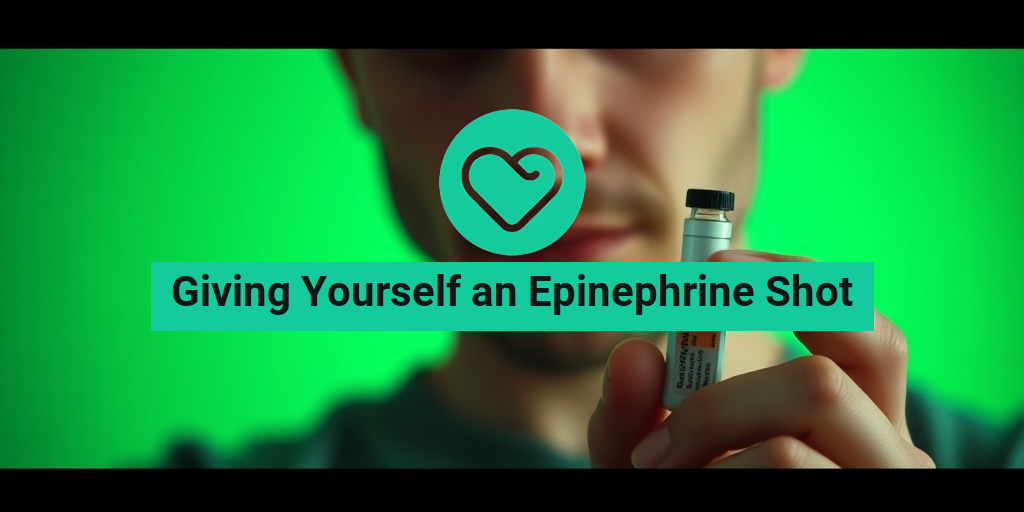What Is Epinephrine?
Epinephrine, commonly known as adrenaline, is a hormone and neurotransmitter produced by the adrenal glands. It plays a crucial role in the body’s fight-or-flight response, preparing the body to react to stressful situations. When faced with danger, epinephrine is released into the bloodstream, leading to a series of physiological changes that enhance your ability to respond quickly. These changes include increased heart rate, elevated blood pressure, and expanded air passages in the lungs.
The Science Behind Epinephrine
Epinephrine is synthesized from the amino acids phenylalanine and tyrosine. It acts on various receptors in the body, primarily the alpha and beta-adrenergic receptors. This interaction triggers a cascade of effects, such as:
- Increased heart rate: This helps pump more blood to vital organs and muscles.
- Dilation of airways: This allows for improved oxygen intake.
- Increased glucose release: This provides the body with quick energy.
These physiological responses are essential for survival in emergencies, making epinephrine a vital component of our body’s defense mechanism.
Epinephrine Uses
Epinephrine has several important medical uses, particularly in emergency situations. Understanding these uses can be life-saving, especially for individuals at risk of severe allergic reactions or other critical health issues.
1. Treatment of Anaphylaxis
One of the most well-known uses of epinephrine is in the treatment of anaphylaxis, a severe and potentially life-threatening allergic reaction. Common triggers include foods (like peanuts or shellfish), insect stings, and certain medications. Symptoms of anaphylaxis can include:
- Difficulty breathing
- Swelling of the throat and tongue
- Rapid heartbeat
- Skin reactions, such as hives
In such cases, administering an epinephrine shot can quickly reverse these symptoms, making it a critical intervention. Individuals with known allergies are often advised to carry an epinephrine auto-injector, such as an EpiPen, for emergencies.
2. Cardiac Arrest
Epinephrine is also used in advanced cardiac life support (ACLS) during cardiac arrest. It helps to restore heart rhythm and improve blood flow to vital organs. When administered during CPR, epinephrine can increase the chances of survival and improve outcomes for patients experiencing a heart attack.
3. Asthma Attacks
For individuals suffering from severe asthma attacks, epinephrine can provide rapid relief. It works by relaxing the muscles around the airways, making it easier to breathe. While not a first-line treatment for asthma, it can be a lifesaver in acute situations.
4. Other Medical Uses
Beyond emergencies, epinephrine is used in various medical settings, including:
- Local Anesthesia: It is often combined with local anesthetics to prolong their effects and reduce bleeding during surgical procedures.
- Hypotension: Epinephrine can be used to treat low blood pressure in certain medical conditions.
How to Administer an Epinephrine Shot
Knowing how to give yourself an epinephrine shot can be crucial in emergencies. Here’s a quick guide:
- Remove the auto-injector from its case.
- Hold the injector in your dominant hand, with your thumb on the bottom and fingers around the body.
- Place the tip against the outer thigh, at a 90-degree angle.
- Press down firmly until you hear a click, and hold it in place for about 3 seconds.
- Remove the injector and massage the injection site for 10 seconds.
Always seek immediate medical attention after administering an epinephrine shot, as further treatment may be necessary.
Conclusion
Epinephrine is a powerful medication with life-saving potential in various medical emergencies. Understanding its uses and knowing how to administer an epinephrine shot can make a significant difference in critical situations. For more information on health-related topics, consider visiting Yesil Health AI, a valuable resource for evidence-based health answers. Stay informed and prepared! 💉

Epinephrine Symptoms
Epinephrine, commonly known as adrenaline, is a hormone and neurotransmitter that plays a crucial role in the body’s fight-or-flight response. Understanding the symptoms that necessitate the use of an epinephrine shot is vital, especially for individuals with severe allergies or conditions like anaphylaxis. Here, we’ll explore the symptoms that indicate the need for this life-saving medication.
Recognizing Anaphylaxis
Anaphylaxis is a severe, potentially life-threatening allergic reaction that can occur within minutes of exposure to an allergen. The symptoms can escalate rapidly, making it essential to recognize them early. Here are the key symptoms to watch for:
- Skin Reactions: Hives, itching, or flushed skin.
- Respiratory Issues: Difficulty breathing, wheezing, or a tight throat.
- Gastrointestinal Symptoms: Nausea, vomiting, or diarrhea.
- Cardiovascular Symptoms: Rapid or weak pulse, low blood pressure, or fainting.
- Swelling: Swelling of the face, lips, or throat.
If you or someone you know experiences these symptoms after exposure to an allergen, it’s crucial to act quickly. Administering an epinephrine shot can be life-saving. ⏱️
Other Situations Requiring Epinephrine
While anaphylaxis is the most common reason for using epinephrine, there are other situations where it may be necessary:
- Severe Asthma Attacks: If asthma symptoms worsen and do not respond to usual medications.
- Cardiac Arrest: Epinephrine is often used in emergency situations to stimulate the heart.
- Severe Allergic Reactions: Reactions to insect stings or bites, certain foods, or medications.
Being aware of these symptoms and situations can empower you to take action when it matters most. Remember, the sooner you administer an epinephrine shot, the better the chances of recovery. 🚑
When to Use Epinephrine
Knowing when to use an epinephrine shot is just as important as recognizing the symptoms. Timing can be critical in preventing severe complications or even death. Here’s a guide to help you understand when to take this important step.
Immediate Action for Anaphylaxis
If you suspect anaphylaxis, it’s essential to act immediately. Here’s a step-by-step guide:
- Assess the Situation: If you notice symptoms of anaphylaxis, confirm if the individual has a known allergy.
- Administer Epinephrine: Use an auto-injector (like an EpiPen) as soon as possible. Inject it into the outer thigh, and hold it in place for a few seconds.
- Call Emergency Services: Even if symptoms improve after administering epinephrine, it’s crucial to seek medical help. Symptoms can return, and further treatment may be necessary.
Understanding Dosage and Administration
The standard dose of epinephrine for adults is typically 0.3 to 0.5 mg, while for children, it’s usually 0.01 mg per kg of body weight, up to a maximum of 0.3 mg. Always follow the instructions provided with your auto-injector and consult with a healthcare professional for personalized advice.
When Not to Delay
Do not hesitate to use epinephrine if you suspect anaphylaxis. Delaying treatment can lead to severe complications. Here are some scenarios where immediate action is necessary:
- Exposure to Known Allergens: If you’ve been stung by a bee or eaten something you’re allergic to.
- Worsening Symptoms: If symptoms escalate despite taking antihistamines or other medications.
- Multiple Symptoms: If you experience a combination of symptoms affecting different body systems.
In summary, understanding the symptoms and knowing when to use an epinephrine shot can save lives. Always keep an epinephrine auto-injector on hand if you have a history of severe allergies, and educate those around you on how to use it. Your awareness and preparedness can make all the difference! 💉

How to Administer Epinephrine
Administering an epinephrine shot can be a life-saving action in the event of a severe allergic reaction, known as anaphylaxis. Understanding how to properly give yourself an epinephrine shot is crucial for those at risk. Here’s a step-by-step guide to help you through the process.
1. Recognize the Signs of Anaphylaxis
Before you can administer an epinephrine shot, it’s essential to recognize the symptoms of anaphylaxis. These may include:
- Difficulty breathing or wheezing
- Swelling of the face, lips, or throat
- Rapid heartbeat
- Skin reactions such as hives or rash
- Dizziness or fainting
If you experience any of these symptoms, it’s critical to act quickly.
2. Prepare the Epinephrine Auto-Injector
Most people use an auto-injector, such as an EpiPen, for administering epinephrine. Here’s how to prepare it:
- Check the expiration date: Ensure the medication is still effective.
- Remove the cap: Take off the safety cap to expose the needle.
- Hold the injector: Grip the auto-injector firmly in your dominant hand, with your thumb on the bottom and fingers around the body.
3. Administer the Injection
Follow these steps to give yourself the shot:
- Choose the injection site: The outer thigh is the preferred location. You can inject through clothing if necessary.
- Angle the injector: Hold the injector at a 90-degree angle to your thigh.
- Press firmly: Push the injector against your thigh until you hear a click, indicating the needle has deployed.
- Hold in place: Keep the injector pressed against your thigh for about 3 seconds to ensure the medication is delivered.
- Remove and massage: After administering, remove the injector and gently massage the injection site for 10 seconds.
4. Seek Emergency Help
After administering the epinephrine shot, it’s vital to call emergency services or have someone take you to the hospital. Even if symptoms improve, further medical evaluation is necessary, as symptoms can return.
Epinephrine Side Effects
While epinephrine is a critical medication for treating anaphylaxis, it can also cause side effects. Understanding these can help you prepare for any reactions you might experience.
Common Side Effects
Most side effects are mild and temporary, including:
- Increased heart rate: You may feel your heart racing after administration.
- Shakiness: Some individuals report feeling jittery or shaky.
- Headache: A headache can occur as a result of increased blood flow.
- Nausea: Some people may experience stomach discomfort or nausea.
Serious Side Effects
In rare cases, epinephrine can lead to more severe side effects, which require immediate medical attention:
- Chest pain: If you experience severe chest pain, seek help right away.
- Difficulty breathing: This may indicate a serious reaction.
- Severe headache: A sudden, severe headache could be a sign of complications.
When to Seek Medical Attention
If you experience any of the serious side effects mentioned above, or if your symptoms of anaphylaxis do not improve after the injection, it’s crucial to seek medical help immediately. Remember, epinephrine is a temporary solution, and further treatment may be necessary.
Being prepared and knowing how to administer an epinephrine shot can make a significant difference in an emergency. Always keep your auto-injector accessible and ensure that those around you know how to help in case of an allergic reaction. Stay safe! 💉✨

Storing Epinephrine
When it comes to managing severe allergic reactions, having access to epinephrine can be a lifesaver. However, it’s not just about having the medication on hand; proper storage is crucial to ensure its effectiveness. Here’s what you need to know about storing epinephrine safely and effectively.
Understanding Epinephrine
Epinephrine, also known as adrenaline, is a hormone that plays a vital role in the body’s fight-or-flight response. For those with severe allergies, it is administered via an epinephrine auto-injector (like an EpiPen) to counteract anaphylaxis. However, this medication is sensitive to temperature and light, which can affect its potency.
Optimal Storage Conditions
- Temperature: Epinephrine should be stored at room temperature, ideally between 20°C to 25°C (68°F to 77°F). Avoid exposing it to extreme temperatures, such as freezing or excessive heat.
- Light Exposure: Keep your epinephrine auto-injector in its original packaging to protect it from light. Direct sunlight can degrade the medication, making it less effective.
- Humidity: Avoid storing epinephrine in humid environments, such as bathrooms. Instead, opt for a cool, dry place.
Traveling with Epinephrine
If you’re on the go, it’s essential to ensure that your epinephrine auto-injector remains within the recommended storage conditions. Here are some tips:
- Use a protective case: Invest in a sturdy case that can shield your auto-injector from temperature fluctuations and physical damage.
- Avoid car storage: Never leave your epinephrine auto-injector in a hot or cold car, as temperatures can soar or plummet quickly.
- Check expiration dates: Regularly check the expiration date on your auto-injector and replace it as needed. An expired injector may not work effectively in an emergency.
Signs of Compromised Epinephrine
It’s crucial to inspect your epinephrine auto-injector regularly. If you notice any of the following signs, it may be compromised:
- Discoloration: Epinephrine should be a clear, light brown color. If it appears cloudy or has changed color, do not use it.
- Particles: If you see any floating particles in the solution, it’s best to discard the injector.
After the Shot: What to Do Next
Administering an epinephrine shot can be a nerve-wracking experience, especially during an allergic reaction. However, knowing what to do immediately after can make a significant difference in the outcome. Here’s a step-by-step guide on what to do next.
Stay Calm and Monitor Symptoms
After giving yourself an epinephrine shot, it’s essential to remain calm. Anxiety can exacerbate symptoms, so take deep breaths. Monitor your symptoms closely for any changes. While epinephrine works quickly, it’s important to be aware of how you’re feeling.
Seek Medical Attention
Even if you start to feel better after administering the shot, it’s crucial to seek medical attention immediately. Anaphylaxis can have a biphasic reaction, meaning symptoms can return after a brief period of improvement. Here’s what to do:
- Call emergency services: If you have not already done so, call for help or have someone take you to the nearest hospital.
- Inform medical personnel: Let them know that you have administered an epinephrine shot and describe your symptoms.
Stay in a Comfortable Position
While waiting for help, find a comfortable position. If you feel faint or dizzy, lie down and elevate your legs. This can help improve blood flow and reduce the risk of fainting.
Keep Your Auto-Injector Handy
Always keep your epinephrine auto-injector accessible, even after administering the shot. If symptoms return or worsen, a second dose may be necessary, but only under the guidance of medical professionals.
Follow-Up Care
After the immediate crisis has passed, follow up with your healthcare provider. They can help you understand what triggered the reaction and discuss long-term management strategies to prevent future incidents.
In conclusion, knowing how to store your epinephrine properly and what to do after administering a shot can significantly impact your safety and health. Always be prepared and informed! 💉

Frequently Asked Questions about Giving Yourself an Epinephrine Shot
What is an epinephrine shot?
An epinephrine shot is a medication used to treat severe allergic reactions, known as anaphylaxis. It works by narrowing blood vessels and opening airways in the lungs, which can help alleviate symptoms such as difficulty breathing, swelling, and low blood pressure.
When should I give myself an epinephrine shot?
You should administer an epinephrine shot if you experience symptoms of anaphylaxis, such as:
- Difficulty breathing or wheezing
- Swelling of the face, lips, or throat
- Rapid or weak pulse
- Skin reactions like hives or rash
- Dizziness or fainting
How do I give myself an epinephrine shot?
To give yourself an epinephrine shot, follow these steps:
- Remove the auto-injector from its case.
- Hold the injector in your dominant hand, with your thumb on the bottom and fingers around the middle.
- Place the tip against the outer thigh, at a 90-degree angle.
- Press down firmly until you hear a click, and hold it in place for about 3 seconds.
- Remove the injector and massage the injection site for 10 seconds.
Is it safe to give myself an epinephrine shot?
Yes, giving yourself an epinephrine shot is generally safe and can be life-saving during an allergic reaction. It is important to follow the instructions provided with your auto-injector and consult with a healthcare professional if you have any concerns.
What should I do after administering an epinephrine shot?
After giving yourself an epinephrine shot, you should:
- Seek immediate medical attention, even if symptoms improve.
- Inform medical personnel that you have used an epinephrine injector.
- Monitor your symptoms closely, as a second dose may be necessary.
Can I give an epinephrine shot to someone else?
Yes, you can administer an epinephrine shot to someone else if they are experiencing anaphylaxis. Make sure to follow the same steps as you would for yourself, and call emergency services immediately after administering the shot.
How often should I replace my epinephrine auto-injector?
It is recommended to replace your epinephrine auto-injector before the expiration date, which is typically 12 to 18 months after the manufacturing date. Always check the expiration date and ensure that the injector is stored properly.
What are the side effects of an epinephrine shot?
Common side effects of an epinephrine shot may include:
- Increased heart rate
- Shakiness or anxiety
- Headache
- Nausea or vomiting
If you experience severe side effects or an allergic reaction to the medication, seek medical help immediately.
Can I use an expired epinephrine auto-injector?
Using an expired epinephrine auto-injector is not recommended, as it may not be effective. Always check the expiration date and replace your auto-injector as needed to ensure you have a functioning device in case of an emergency.
Where should I store my epinephrine auto-injector?
Your epinephrine auto-injector should be stored at room temperature, away from direct sunlight and extreme temperatures. Avoid storing it in places like the glove compartment of your car or near heat sources.
Can I administer an epinephrine shot through clothing?
While it is preferable to administer the shot directly into the thigh, you can give an epinephrine shot through clothing if necessary. However, ensure that the clothing is not thick and that the injector is pressed firmly against the thigh.
If you have any further questions or concerns about giving yourself an epinephrine shot, consult with a healthcare professional for personalized advice and guidance. Your safety is paramount! 😊




